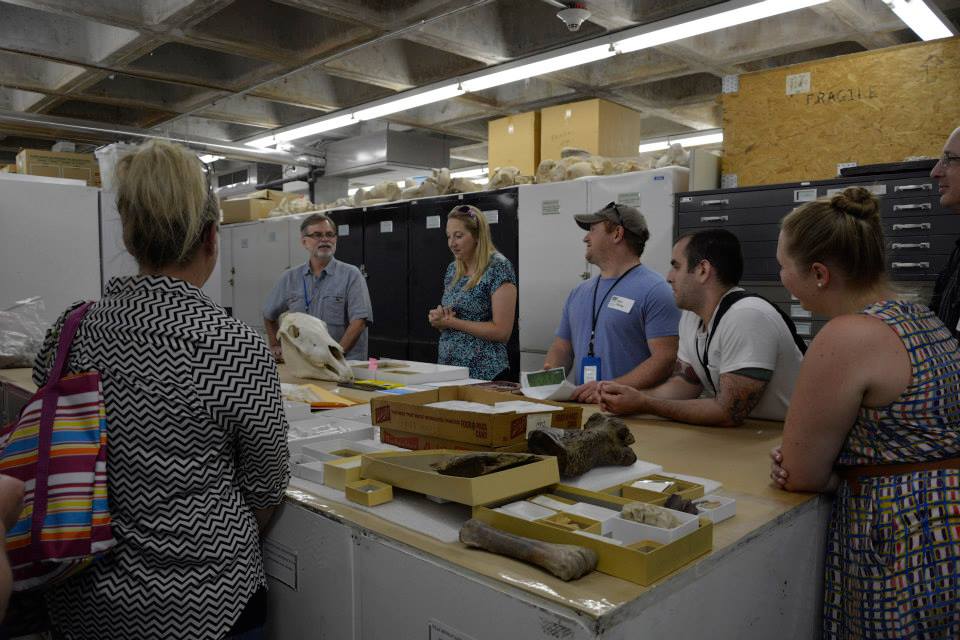By Julie Bokor, Doctoral student Science Education, University of Florida, Jennifer Broo, Science teacher, Cincinnati, OH, & Jessica Mahoney, Science teacher, Orlando, FL

Evolution forms the basis for all biology, yet teachers face many challenges in their efforts to teach this material. The concepts and time-scales are difficult for many students to grasp, and many come to the classroom with negative perceptions about evolution.Clearly, teachers need as many tools as possible to engage students and facilitate their understanding of evolutionary biology.
In a pilot program supported by the Smallwood Foundation and developed by the University of Florida Center for Precollegiate Education and Training (CPET), 10 teachers were invited to the UF campus to explore evolutionary biology projects at the elbows of university researchers. One of the stops was the vertebrate paleontology collection, where Bruce MacFadden presented teachers with a study set with fossil horse teeth from a dozen different species and charged them with creating a classroom lesson.

Working in two teams of five teachers each, the teachers brainstormed ideas to incorporate the fossils into the curriculum. Their ideas were further refined by two teachers who remained on campus for an additional week and crafted a three-lesson module exploring both macro- and micr-oevolution. Through hands-on inquiry utilizing horse fossil teeth, the lessons help students understand evolution and the role the environment plays in the evolutionary processes.
Our hope is that by using a familiar organism, the horse, and engaging in the authentic practices of science including the opportunity to study actual fossils, students will begin to appreciate the elegance and predicative power of evolutionary theory. The activities in this unit require no prerequisite understanding of evolution or vocabulary associated with evolution. This hands-on inquiry approach to introducing evolution will hopefully result in greater acceptance and understanding of evolution.

Starting in lesson one of Chewing on Change: Exploring Co-Evolution of Horse and Plants in Response to Climate Change, students view a slide show of illustrations representing the physical landscape of each of the five geological epochs and make observations about the types of flora present. Next, in collaborative learning groups, students measure and sketch physical characteristics of fossilized horse teeth from a study set provided by the Florida Museum of Natural History (FLMNH). Each group produces a graph that summarizes the trend between age of the fossil and length of the tooth. Plant information cards summarizing each epoch are provided to each group, and guided analysis questions allow students to develop an explanation for the change in horse teeth in response to plant evolution.

In the second lesson, students are provided with images of horse teeth collected from Thomas Farm, Florida. Students take measurements to determine if this collection represents individuals from the same species. Students also use the graphs produced in Lesson One to determine which species this population likely belonged to. Additionally, students determine if there is intraspecies variation in this population using a horse tooth variation guide. Students consider how and why variation exists within a species and predict what would happen to horse teeth in future generations if plant life drastically differed again on Earth, drawing upon information gathered in lesson one.
The final lesson presents students with a real-life problem observed in many natural history museums: horse evolution is depicted as occurring in a straight line (orthogenesis) rather than the widely accepted branching phylogenetic tree (MacFadden et al., 2012). This incorrect graphical representation has been shown to promote misconceptions about evolution. Students either read a letter from the curator of a natural history museum requesting their help with this problem or study a paper by MacFadden and colleagues (2012) that explores this issue. Using the fossil data graphs from Lesson One in addition to information about ancestral horse species, the students summarize how the fossil records clearly show a branching phylogenetic evolution of the horse and suggest how this can be better addressed in museum exhibits by creating and sharing posters.
The first implementation of this curriculum in an Honors Biology class in Cincinnati, Ohio was very successful. Students demonstrated both cognitive learning gains as well as sustained interest in the subject matter. Additional pilot testing in diverse classroom contexts are planned and outcomes shared.

To learn more about Chewing on Change, contact Julie Bokor at [email protected]
The most recent version of the curriculum can be found at:
http://prod.cpet.ufl.edu/wp-content/uploads/2014/06/Horse-Evolution-Lessons-final-9_11_2014.pdf
For further reading:
MacFadden, B. J., Oviedo, L. H., Seymour, G., & Ellis, S. (2012) Fossil Horses, Orthogenesis, and Communicating Evolution in Museums. Evolution: Education and Outreach, 29-37. Download PDF (1602 KB) View Article